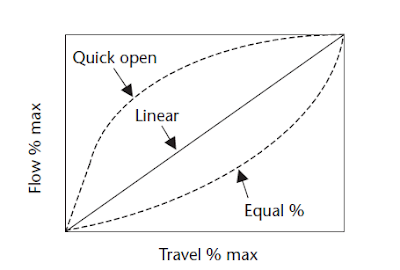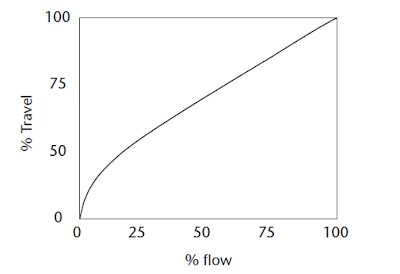Flow control
valves forms an important component of any industrial instrumentation system and
control system. When a change in a measured variable with respect to a
reference has been sensed, it is necessary to apply a control signal to an
actuator to make the corrections to an input controlled variable for example via
a valve bringing the measured variable back to its preset value.
Globe Valve
You can also read:
Butterfly Valve
In most
cases, any change in the variables e.g. Temperature, Pressure, and Level) can
be corrected by controlling the flow rates. The actuators used to control valves for flow
rate control can be electrically, pneumatically or hydraulically controlled.
Actuators
can be self-operating in local feedback loops. The two most common types of
variable devices used for flow control are the globe valves and the butterfly
valve.
Globe Valve
Let’s
consider the following diagram:
The actuator
controlling the valve can be controlled or driven electrically, pneumatically
or hydraulically.
The actuator
determines the speed of travel and the distance that the valve shaft travels.
We have various
Globe valve configurations. The globe valve can be designed for quick opening
operation, for equal percentage operation or with a linear relationship between
flow and lift or any combination of these. We also have other configurations
like two-way valve (diverging type) and three-way valve.
The
selection of the type of control plug depends on a careful analysis of the
process characteristics. If the load changes are linear, then a linear plug
should be used; conversely, if the load changes are nonlinear, then a plug
with the appropriate nonlinear characteristics should be use.
Other types
of Globe valves include: Needle valve, which has a diameter of 1/8 to 1 inch
size. The balanced cage-guided valve and the split body valve.
Note: Globe
valves aren’t suitable for use with slurries.
You can also read:
Butterfly Valve
A butterfly
valve consists of a cylindrical body with a disk the same size as the internal
diameter of the valve body, mounted on a shaft that rotates perpendicular to
the axis of the body.
The relationship
between flow and lift is approximately 50 % open, after which it is linear.
Butterfly
valves offer high capacity at low cost. They are also simple in design, are
easy to install and have tight closure. The torsion force on the shaft
increases until the valve is open 70° then reverses.
Butterfly
valves have a limited pressure range, and are not used for slurries.
Don't miss out on key updates, join our newsletter list here.




Butterfly valves are versatile flow control devices known for their simplicity and efficiency. With a quarter-turn operation, they offer quick and precise control of fluid or gas flow. Their compact design and lightweight construction make them easy to install and maintain, making butterfly valves a popular choice in various industrial applications. Whether in water treatment plants or HVAC systems, these valves provide reliable and cost-effective solutions for regulating flow.
ReplyDeleteButterfly Valve Manufacturer